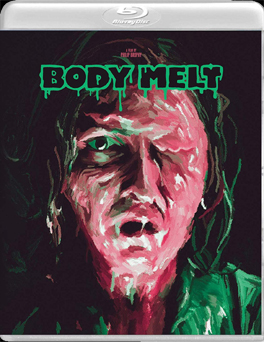 BODY
MELT (1993) Blu-ray/DVD Combo
BODY
MELT (1993) Blu-ray/DVD ComboDirector:
Vinegar Syndrome
 BODY
MELT (1993) Blu-ray/DVD Combo
BODY
MELT (1993) Blu-ray/DVD ComboThe residents of Pebbles Court are dying to get healthy… literally in the gruesomely gory Ozploitation splatter pic BODY MELT, out on Blu-ray/DVD combo from Vinegar Syndrome.
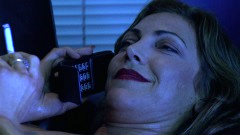
When chemist Ryan (Robert Simper, MAD MAX BEYOND THUNDERDOME) discovers the unethical experiments being conducted by Vimuville on residents of the Melbourne housing development Pebbles Court, he heads there in order to warn Paul Matthews (William McInnes, THE HEARTBREAK KID), one of the subjects chosen for testing of the experimental drug V9. Unbeknownst to Ryan, the clinic’s supervisor Dr. Shann (Regina Gaigalas, DEAD END) has dosed him to the gills with V9, smaller doses of which have interesting effects on Shann’s own libido. Ryan starts experiencing the deadly effects of the drug and he crashes into a van in Pebbles Court. On the case are detectives Phillips (Gerard Kennedy, ELIZA FRASER) and Johnno (Andrew Daddo) who write it off as a drug-induced fatality. An empty Vimulville pill bottle takes the detectives to the company headquarters (a health farm in the middle of the outback) but they learn nothing helpful until forensics tech forensics tech (Bill Young, THE MATRIX) comments on the unnatural health of the victim suggests that the unrecognizable drugs in his system are experimental cognition enhancers, and the detectives also notice that the victim had scribbled Matthews name on his arm. Back in Pebbles Court, however, Matthews who has started hallucinating and is undergoing glandular changes, cousins Sal (Nick Polites, HERCULES RETURNS) and Gino (Maurie Annese) are on their way to the health farm to give sperm samples to the hot doctor, the Noble family are also on their way to the health farm for a vacation they’ll never forget, and pregnant neighbor Cheryl (Lisa McCune, LITTLE FISH) has been experiencing strange nightmares and confides in suspicious Dr. Carrera (Ian Smith).
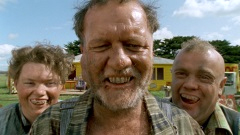 Were
it not for the film’s sense of black humor, BODY MELT – with its
extremely gruesome and explosive death scenes, combined with some sexualized
violence as well as a brief shot of hardcore imagery on a television screen
– the film could have been seen as not particularly well-developed pharmaceutical
spin on Cronenbergian body horror. Director Philip Brophy was an musician –
having formed the group whose symbolic name is pronounced Tsk Tsk Tsk –
who had made an experimental short film SALT, SALIVA, SPERM, AND SWEAT before
tackling the feature length BODY MELT for which he also composed the score and
designed the sound (disc hostess Katarina Leigh Waters refers to Brophy –
due partially to his use of multiple modes of media for expression, including
academic publications – as the Australian Clive Barker). The film is more
of a catalogue of gruesome deaths rather than a thriller or horror film. The
audience knows everything from the start and are far ahead of the detectives,
and the only subsequent surprises of any novelty are not the identities of the
additional perpetrators but just what special make-up effects of Bob McCarron
(DEAD ALIVE) will come up with for the next death scene. Sal and Gino getting
waylaid on their way to the clinic by Pud (Vincent Gil, THE DAY AFTER HALLOWEEN)
and his mutant family does eventually dovetail into the main plot, but even
after it does, it still feels like a major – though admittedly entertaining
– plot detour. The quasi-mythological form of Matthews’ hallucinations
and the doctor referring to babies as the “ultimate parasite” up
until their birth when explaining away Cheryl’s nightmares hint at profundity,
but the film as a whole isn’t particularly thought-provoking and is better
enjoyed than absorbed.
Were
it not for the film’s sense of black humor, BODY MELT – with its
extremely gruesome and explosive death scenes, combined with some sexualized
violence as well as a brief shot of hardcore imagery on a television screen
– the film could have been seen as not particularly well-developed pharmaceutical
spin on Cronenbergian body horror. Director Philip Brophy was an musician –
having formed the group whose symbolic name is pronounced Tsk Tsk Tsk –
who had made an experimental short film SALT, SALIVA, SPERM, AND SWEAT before
tackling the feature length BODY MELT for which he also composed the score and
designed the sound (disc hostess Katarina Leigh Waters refers to Brophy –
due partially to his use of multiple modes of media for expression, including
academic publications – as the Australian Clive Barker). The film is more
of a catalogue of gruesome deaths rather than a thriller or horror film. The
audience knows everything from the start and are far ahead of the detectives,
and the only subsequent surprises of any novelty are not the identities of the
additional perpetrators but just what special make-up effects of Bob McCarron
(DEAD ALIVE) will come up with for the next death scene. Sal and Gino getting
waylaid on their way to the clinic by Pud (Vincent Gil, THE DAY AFTER HALLOWEEN)
and his mutant family does eventually dovetail into the main plot, but even
after it does, it still feels like a major – though admittedly entertaining
– plot detour. The quasi-mythological form of Matthews’ hallucinations
and the doctor referring to babies as the “ultimate parasite” up
until their birth when explaining away Cheryl’s nightmares hint at profundity,
but the film as a whole isn’t particularly thought-provoking and is better
enjoyed than absorbed.
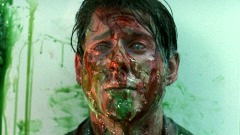
BODY MELT made its stateside debut on VHS in 1994 courtesy of Prism Entertainment in a cropped though serviceable transfer with good Hi-Fi stereo sound (the film did not carry an MPAA rating, but the tape carried an AO (Adults Only) rating by the Film Advisory Board (presumably Prism only used the “unrated” denotation for films that they also released in Blockbuster-friendly R-rated editions). Vanguard released the film on DVD in 2003, also a fullscreen transfer with an upmixed 5.1 soundtrack. Scorpion’s issued an attractive anamorphic widescreen (1.66:1) transfer sourced from the 35mm blow-up elements, which was also the source for the Australian Blu-ray from Umbrella Entertainment. Derived from a 4K scan of the original 16mm camera negatives, Vinegar Syndrome's 1080p24 MPEG-4 AVC 1.78:1 widescreen transfer reveals a sliver more information on the left, a little more on the top but less on the bottom of the frame. The colors are a little cooler than the Scorpion master which has the effect of making some finer detail more evident in places where the DVD's warmer and more saturated color does not; however, the color boosting of the DVD gave the film an exaggerated look that seems part of the film's take on both the artifice of suburbia as well as the outback settings and characters. The Blu-ray fares better, on the other hand, in scenes in which the lighting employs saturated gels where highlights on skin looked almost neon. The DTS-HD Master Audio 5.1 track is a brand new remix – details of which are covered in the second commentary track – and optional English SDH subtitles are included.
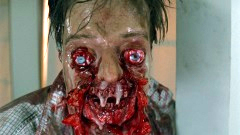 Extras
start with an audio commentary by writer/director/composer Brophy, writer/producer
Rod Bishop, and producer Daniel Scharf (ROMPER STOMPER) in which Brophy and
Bishop recall the unexpected success of their non-mainstream long-short film
SALT, SALIVA, SPERM AND SWEAT – Brophy credits Bishop with navigating
the Australian Film Commission requirements for him – and how they then
developed a four story anthology film that had no takers until they reconfigured
the four stories into the single narrative of BODY MELT using the Pebble Court
setting as the framework for the four strands of the film. Scharf provides more
background into the funding, including the changes that were taking place with
the Australian Film Commission that made possible the funding of more low-budget
films in the nineties. Brophy also discusses how he was inspired by his dissatisfaction
with how Australian suburban life was depicted on television and how his false
aesthetic of suburbia that looks as if it would crumble at any moment was mirrored
in the fates of the characters, and how the familiar actors recruited from television
shows like NEIGHBOURS were game for some gory fun that took jabs at their television
image. The second audio commentary by Brophy was recorded directly after the
first and focuses on the scoring and sound design of the film. Although he discusses
how various sound effects were conceived and created, the most interesting part
of the talk is actually about the 5.1 remix. He initially intended to just embellish
the original Dolby Stereo track only to watch a DVD and find that somewhere
down the mixing chain the track had been more conservatively balanced and panned
than in his original mix. He had the original magnetic tracks digitized only
to discover that the panning of the mix meant that some left and right stereo
music and effects had bled into the center channel which he had to filter out
digitally to the best of his abilities. The original music and effects tracks
that ran at 25fps and also had some panning issues.
Extras
start with an audio commentary by writer/director/composer Brophy, writer/producer
Rod Bishop, and producer Daniel Scharf (ROMPER STOMPER) in which Brophy and
Bishop recall the unexpected success of their non-mainstream long-short film
SALT, SALIVA, SPERM AND SWEAT – Brophy credits Bishop with navigating
the Australian Film Commission requirements for him – and how they then
developed a four story anthology film that had no takers until they reconfigured
the four stories into the single narrative of BODY MELT using the Pebble Court
setting as the framework for the four strands of the film. Scharf provides more
background into the funding, including the changes that were taking place with
the Australian Film Commission that made possible the funding of more low-budget
films in the nineties. Brophy also discusses how he was inspired by his dissatisfaction
with how Australian suburban life was depicted on television and how his false
aesthetic of suburbia that looks as if it would crumble at any moment was mirrored
in the fates of the characters, and how the familiar actors recruited from television
shows like NEIGHBOURS were game for some gory fun that took jabs at their television
image. The second audio commentary by Brophy was recorded directly after the
first and focuses on the scoring and sound design of the film. Although he discusses
how various sound effects were conceived and created, the most interesting part
of the talk is actually about the 5.1 remix. He initially intended to just embellish
the original Dolby Stereo track only to watch a DVD and find that somewhere
down the mixing chain the track had been more conservatively balanced and panned
than in his original mix. He had the original magnetic tracks digitized only
to discover that the panning of the mix meant that some left and right stereo
music and effects had bled into the center channel which he had to filter out
digitally to the best of his abilities. The original music and effects tracks
that ran at 25fps and also had some panning issues.
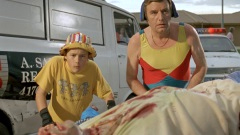
Newly shot is "Melting Away: The Deconstruction of BODY MELT" (38:36) with Brophy and Bishop, which is a more focused version of the commentary stories and also includes discussion of the intentional "televisual" veneer of the film and veteran McCarron's enthusiasm for the project and pride in certain effects like the full body autopsy prosthetic. Scharf appears separately "Body Building: The Making of Body Melt" (8:06) discussing the changes to the government funding of films in the nineties that made it possible for lower-budget productions to get a substantial tax break, while many productions of the period moved towards self-financing an relying on the commission for completion funds. Also new is "Adrenal Glands" (10:32), an interview with actor Neil Foley (ANGEL BABY) who was a student in Brophy's film sound class when the film was being developed and begged to audition for it, as well as how this role and that of a short film he made just before lead to his typecasting in subsequent work.
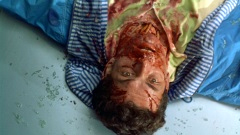 Ported
over from the Australian Blu-ray is the 1992 "Making Bodies Melt: The Making
of BODY MELT" documentary (33:55) in which Brophy and Bishop appear in
clips discussing how the film is hard to classify in terms of the range of conventional
horror films while some of the actors like Kennedy and Gil describe the script
as different, "more than horror," and that Australians "need
to be upset" (which suggests that Brophy was not alone in his "anti-NEIGHBOURS"
stance). The behind the scenes featurette (16:54) consists of the video excerpted
throughout the above documentary, cutting back and forth between camcorded video
of the shoot and telecined video of the scenes being shot. The disc also includes
a complete storyboard gallery, behind-the-scenes gallery, a stills and props
gallery, and the film's theatrical trailer (1:40). The cover is reversible and
a run of 2,000 copies ordered directly from Vinegar
Syndrome will include a slipcover. (Eric
Cotenas)
Ported
over from the Australian Blu-ray is the 1992 "Making Bodies Melt: The Making
of BODY MELT" documentary (33:55) in which Brophy and Bishop appear in
clips discussing how the film is hard to classify in terms of the range of conventional
horror films while some of the actors like Kennedy and Gil describe the script
as different, "more than horror," and that Australians "need
to be upset" (which suggests that Brophy was not alone in his "anti-NEIGHBOURS"
stance). The behind the scenes featurette (16:54) consists of the video excerpted
throughout the above documentary, cutting back and forth between camcorded video
of the shoot and telecined video of the scenes being shot. The disc also includes
a complete storyboard gallery, behind-the-scenes gallery, a stills and props
gallery, and the film's theatrical trailer (1:40). The cover is reversible and
a run of 2,000 copies ordered directly from Vinegar
Syndrome will include a slipcover. (Eric
Cotenas)